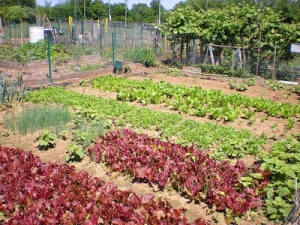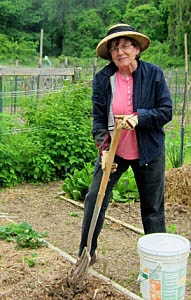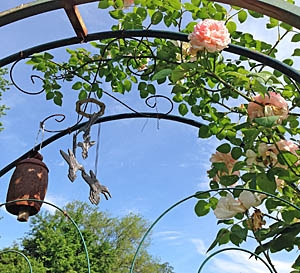Community Garden Plots: An Option Worth the Wait
by Jo Anna Natale, Fairfax Master Gardener
 Tending a community garden plot is a popular pastime in Fairfax County. Those who have plots will tell you they love them for the fresh harvests they yield, the plant-minded people they attract, and the open-air exercise they afford.
Tending a community garden plot is a popular pastime in Fairfax County. Those who have plots will tell you they love them for the fresh harvests they yield, the plant-minded people they attract, and the open-air exercise they afford.
In fact, some community gardeners are so keen on their rental plots that they keep them for years. This loyalty, however, along with a growing general interest in raising one’s own food, has contributed to a shortage of garden plots available in the county. In some cases, waiting lists to get one can run as long as two years.
To reduce the wait, some plot providers are taking steps to add more gardening spaces. The Reston Association, for example, recently increased to 330 the number of garden plots available to its members. The Fairfax County Park Authority, which maintains a 500-person waiting list for its 671 spaces, is considering more plots, while The City of Fairfax is holding steady at 38 plots.
Still, officials from all three of those sources say the waits shouldn’t cause discouragement among wannabe community gardeners. If you meet the criteria for renting (see “Community Gardening Facts and Figures” below) and want to give gardening among others a go, get on the list.

Carolyn Sutterfield prepares a bed in her community garden plot in Vienna’s Nottoway Park
Carolyn Sutterfield, a retired editor, has been a community gardener in Vienna’s Nottoway Park for 23 years. Unlike many who seek community plots because their apartments or townhomes don’t have yards, Sutterfield could grow vegetables at her Fairfax house, but only in its one sunny spot—her front yard. “By being here instead,” she says, “I’m doing my neighbors a favor. I’ve been gardening long enough to know that veggie gardens can get really messy.”
At the moment, her patch grows neat rows of radishes, lettuces, carrots and dill, with peppers, squash and raspberries on the way. Gardening in the same spot for nearly a quarter century, Sutterfield has come to know some of her fellow gardeners well, such as the man to the left, who mostly grows beans and tomatoes, and the woman two plots over, whose space bursts with purple phlox, Shasta daisies, and grapevines.
The chance to grow one’s own food or flowers is an obvious benefit of community gardening, but the chance to interact with others also appeals, says Patricia Dietly, the park authority’s garden plot coordinator. Dietly says she sees people making multinational connections—“We have 10 languages spoken”—as well as multigenerational ones: “I see grandparents with their grandchildren helping scoop mulch, or older parents with their adult children working together in the garden instead of watching a football game inside.”
Another plus, Dietly says, is continuity. As long as they follow the rules, gardeners can return to the same plot year after year, investing it with “some of their own personality.”

Rajab Doski’s garden gate
An Oakton resident, Doski says what keeps him coming back to his plot is the fresh, healthful produce he takes out, as well as the way working in his garden makes him feel: “I grew up in the garden. Every year I have to put something in the dirt, or I’m not happy.”
As plot costs rise (the $125 rent for a park authority plot, for example, has doubled in the past three years), Sutterfield says she sometimes wonders whether the size of her harvest is worth the expenses. Still, she says, her garden provides good exercise and, as long as she is physically able, she’ll probably keep coming here. After all, being outdoors in nature bestows its own pleasures. “The birds are lovely,” Sutterfield says, pointing to an oriole gliding to a nearby tree. “And if I stay late into the evening, I get the fireflies.”
Community Garden Plot Facts and Figures
Fairfax County Park Authority
• 671 plots in nine county parks
• Must be Fairfax County resident to obtain a plot
• Annual rental fee is $125
• Most plots are 20 x 30 feet
• Gardeners can use organic or nonorganic methods
Reston Association
• 330 plots in four locations
• Must be an association member to obtain a plot
• Annual rental fee is .30 per square foot
• Plots are between 90 and 600 square feet
• Three of four locations require organic methods
City of Fairfax
• 38 plots in two locations
• Must be a City of Fairfax resident to obtain a plot
• One-time $50 deposit, then annual rent of $60 for a full plot, $30 for a half plot
• Plots are 10 x 10 feet (full), 5 x 10 feet (half)
• All plots require organic methods
Resources
Fairfax County Garden Plots
City of Fairfax Garden Plots